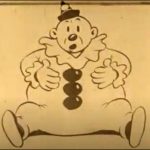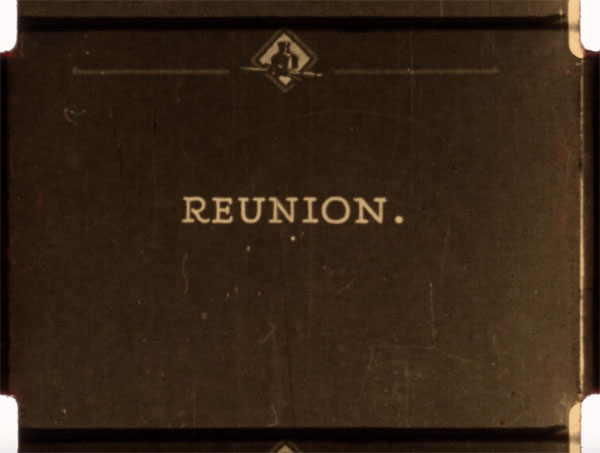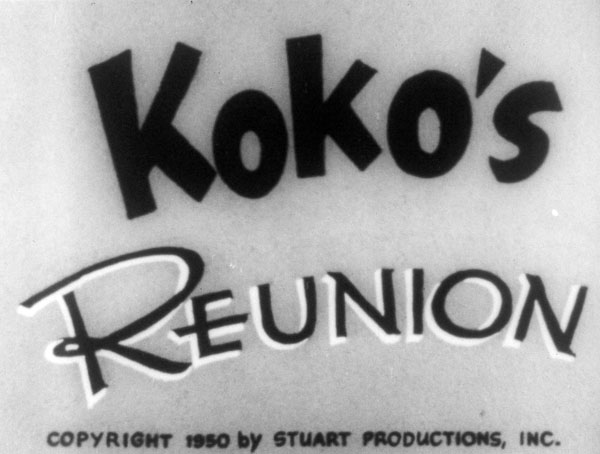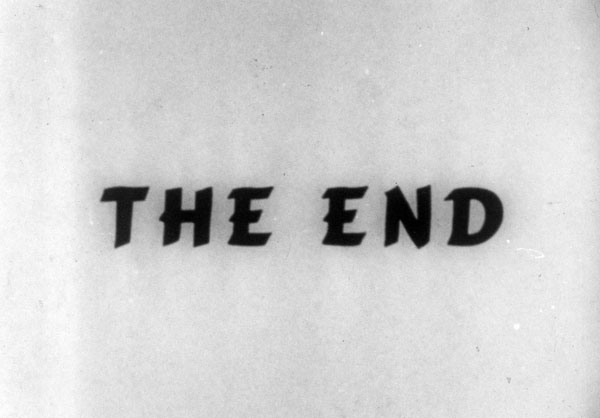Reconstructing a Silent Cartoon “Reunion” (1922)
Posted by admin on


A Message From Steve: “It’s a little less Thunderbean this week and a lot more Cartoons on Film! I’ll be back next week, but this week Tommy Stathes steps in while I work on getting a film to final cleanup tonight!
A new a pre-order is available at the Thunderbean Shop.
It’s Harman/Ising Rarities – a Blu-ray set we’ve been working on already for a little while.
Have a good week all! Tommy, take it away…”
– Steve Stanchfield

Dear Cartoon Researchers: Your regularly scheduled dose of Thunderbean Thursdays is being postponed until next week! A little bird has told me Steve Stanchfield is very busy working on a special rush project (see box above) this week. Therefore, he’s turning today’s slot over to Cartoons On Film.
In keeping with the usual Thunderbean Thursdays spirit, I’d like to give you a behind-the-scenes look at one of the films that I currently have in the restoration pipeline. Earlier this year, some readers may recall that I had been crowdfunding two new Cartoon Roots Blu-ray/DVD releases — featuring Walter Lantz’s silent-era Bray cartoons such as Dinky Doodle, as well as some of Fleischer’s early Out of the Inkwell shorts [LINK]. What I’ll share here today is the curious story of one of the Inkwell shorts: Reunion (1922).

If one thing is true of most silent era cartoons, it’s that many of them are quite rare. Many hundreds of them are still considered lost! By ‘lost,’ film historians and archivists usually wish to imply that there are no copies of a particular film known to exist among most institutional archives, or among most well-known private collections. However, the situation happens to be a bit more optimistic than that, in my view. Copies of previously rare, and even ‘lost’ films do turn up from time to time—whether they be chance finds at flea markets or in innumerous basements and attics and barns throughout the world, or even simply as previously-misidentified or unidentified prints that already exist in dedicated film collections.
A lot of my work relies on coming across more and more of these prints. What’s more, my restoration work often relies on using multiple prints of the same film—whenever possible. It’s a difficult, but necessary task to use multiple prints, as so many of these early films had been edited or physically damaged over the years. That brings us back to Reunion (1922).
Sadly, 35mm elements no longer exist for many of these cartoons. The main element I’ve had to work with for this particular restoration, so far, has been my own tinted 16mm Kodascope print, which was struck in 1927. This Kodascope print, while visually charming, has a few physical splices in the print which obliterate the flow of some shots. In a situation like this, I’d normally seek out another print of similar vintage and provenance. Sadly, I’ve had difficulties accessing another one.
Before I go any further, I’ll share a bit about the story behind Kodascope prints. Back in the 1920s, the 16mm film gauge was growing in popularity—it was far more portable and inexpensive to use, in comparison with 35mm film, and this made it an ideal format for average consumers. Finally, filmmaking was becoming more accessible to the masses!
By 1924 or so, and in response to this new trend, the Eastman Kodak company founded a rental library called Kodascope Libraries. Kodascope aimed to provide consumers with licensed prints of famous theatrical films, and educational shorts—all of which could now be shown in someone’s home. This was true, so long as prospective borrowers had the space and money to either buy or rent a 16mm film projector, and the wherewithal to rent prints for showing at home. Schools, churches, libraries, and other organizations would also partake in these rentals. Simple put, 35mm projection was more cumbersome, more expensive, and often dangerous, if nitrate film was being used for presentations. The answer to this problem was 16mm film.
The incredible thing about the Kodascope Libraries prints is that they were printed from 35mm negatives. The resulting quality was stunningly sharp. Quite a few silent era cartoons were given this Kodascope treatment, and that includes a handful of the Inkwell shorts. These prints are somewhat rare, and sometimes they are quite worn when they turn up. They’re now almost a hundred years old. That’s why my print has a few problems.
Thankfully, I do have a secondary element to work with in this Reunion restoration project. Beginning in 1950, a firm called Stuart Productions optioned some of the old Out of the Inkwell films for television distribution. After all, television was a fairly new medium and not a lot of new programming was available for syndication at the time. Old cartoon material like this was suitable for use in hosted kiddie shows. One such example was “Uncle Fred” Sayles’ Junior Frolics, which was seen by countless thousands of children here in the New York City area from about 1948 to the early or mid 1950s. Or, sometimes these kinds of old cartoons were used as generic time slot fillers. We owe a lot to the distributors who wound up repackaging these old films for television, as sometimes these 1950s versions are now the only surviving prints of otherwise lost early silent cartoons.

What’s the problem, then? Stuart Productions completely replaced all of the original main and end titles, as you can see above. What’s more, all of the intertitles were also excised for these new TV printings. That leaves us with versions of these films that only contain the original cartoon or live action footage, sans all of the on-screen explanations or written dialogue. That’s okay, though—I already had those elements in the old Kodascope print! Problem solved. Or so I thought.
Some readers might have surmised by now that compositing both prints together would be a simple and straightforward task. Not so much the case, as my trusty editor David Grauman soon discovered. Dave recently started to compare both prints in digital post-production, and he then began cutting together a new composited version for me to review before cleanup could begin. Since the Kodascope had a few physical splices in the print, all I thought was needed would be little bits of replacement footage from the secondary print, in order to fill in whatever was lost to the physical splices in my original Kodascope print. Below, you’ll see an example of one of the physical splices in question. Watch for the splice in the close-up shot of Max Fleischer handling a toy car, and you’ll see a very noticeable skip in the action.
Here’s where it gets even more interesting. During the editing process, Dave found that many of the shots in the Kodascope negative were actually shorter than they should have been. Quite a few frames were missing at the beginnings and ends of some shots, and sometimes in the middle of certain shots. These cuts were seamless in the resulting release print. I suspect what happened was that Kodascope’s 35mm dupe negative was simply cut differently from another master element. Or, Kodascope’s negative may simply have become shortened over time, in a more organic way, from simple wear and tear. The cuts don’t appear in the picture area of the resulting print because these would have been very discreet, and very well made lab splices.
 In any case, the TV version seems to have been prepared from a superior, and more complete master element that may have even predated Kodascope’s own circa 1924 35mm negative. Perhaps the original camera negative, or a master positive was used. This means the TV version wound up having more frames from many shots, and that was a complete surprise to me. I had no clue some of this footage was even missing! The only downside here is that the TV print is a bit soft, giving an overall look that isn’t as sharp or as generally superior as the Kodascope happens to be. This is the sort of conundrum I’m coming up against constantly, in my restoration work.
In any case, the TV version seems to have been prepared from a superior, and more complete master element that may have even predated Kodascope’s own circa 1924 35mm negative. Perhaps the original camera negative, or a master positive was used. This means the TV version wound up having more frames from many shots, and that was a complete surprise to me. I had no clue some of this footage was even missing! The only downside here is that the TV print is a bit soft, giving an overall look that isn’t as sharp or as generally superior as the Kodascope happens to be. This is the sort of conundrum I’m coming up against constantly, in my restoration work.
I do happen to know of another very good condition Kodascope print of Reunion in a private collection. Sadly, the other Kodascope print remains inaccessible because of the owner’s rather difficult nature. If I’d been able to access that alternate Kodascope print, it could have made this particular restoration just a little bit easier and more uniform—we would have been able to ‘borrow’ less footage from the TV print, for one thing.
Have a look at some of the composited footage, in our new rough cut. The amber tinted footage is the 1927 Kodascope print, and the more pleasing ‘master’ element in this project. The softer, flatter looking black and white frames are the new bits that have been taken from the TV version, and inserted back into our new edit. A great big thanks goes out to David Grauman again, for his fine work on this.
Now that this new final edit of Reunion has been made, the softer TV print footage will be digitally tweaked in post production, in order to more closely match its overall look with the better-looking Kodascope footage. Then, all of the footage will be steadied and cleaned up. Whew. While the restoration work is still underway, a new musical score has just now been recorded for this film by a very esteemed silent film accompanist. That’s all I’m at liberty to say about this and other projects, for today!

As a final note, I do want to mention that I’m currently doing a bit of fundraising for my 16mm Cartoon Carnival series. We were finally able to resume screenings here in New York City this summer, safe and socially distanced in a Brooklyn backyard space. However, more than a year’s worth of event income had been lost because of necessary lockdowns. The proceeds from these shows directly cover the cost of maintaining my film print archive in off-site storage, and losing that income turned out to be a terrible financial burden for me, and subsequently a great risk to the films in storage. Some friends and colleagues have asked how they could help get this itinerant film screening series back and track, which would also help cover the cost of archival storage. As a result, I’ve set up a GoFundMe campaign for this purpose. I’m grateful to everyone who has chipped in so far, and a thanks in advance to any readers who might be able to chip in!

In any case, stay tuned for more news about my various ongoing silent cartoon restoration projects…and in the meantime, let’s enjoy the return of Thunderbean Thursdays, next week.






